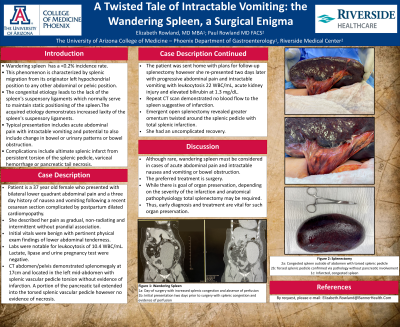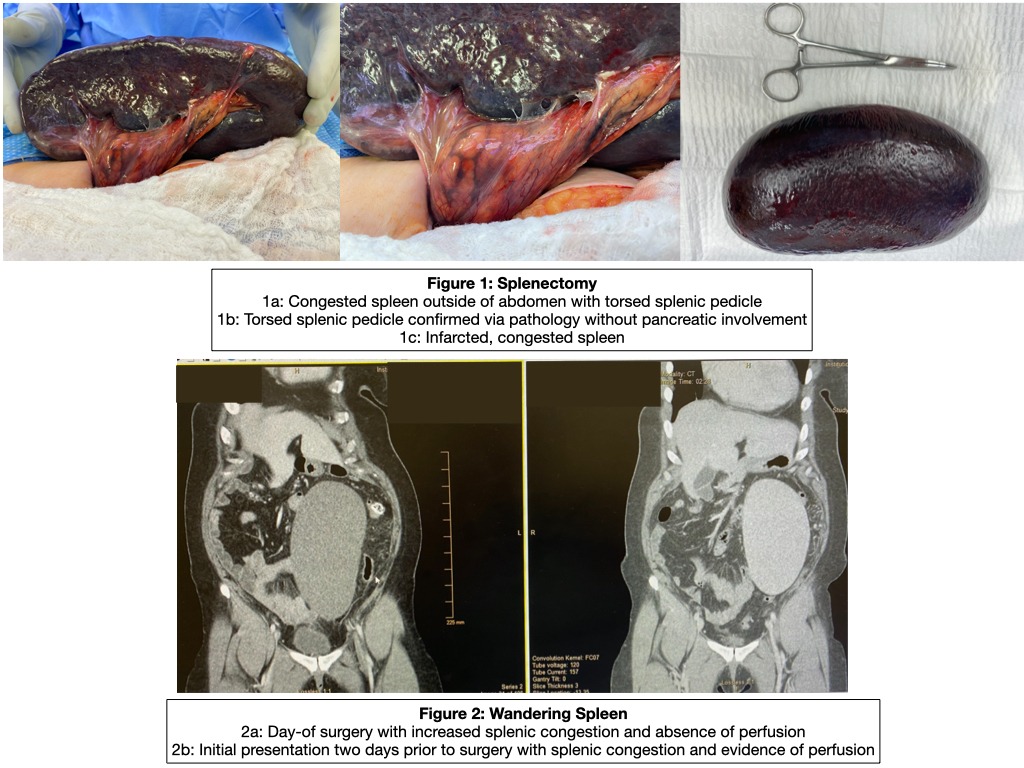Monday Poster Session
Category: Biliary/Pancreas
P1541 - A Twisted Tale of Intractable Vomiting: The Wandering Spleen
Monday, October 23, 2023
10:30 AM - 4:15 PM PT
Location: Exhibit Hall

Has Audio

Elizabeth A. Rowland, MD, MBA
University of Arizona College of Medicine
Phoenix, AZ
Presenting Author(s)
Award: Presidential Poster Award
Elizabeth A. Rowland, MD, MBA1, Paul Rowland, MD2
1University of Arizona College of Medicine, Phoenix, AZ; 2Riverside Medical Center, Bourbonnais, IL
Introduction: Wandering spleen is a rare clinical condition with a less than 0.2% reporting incidence rate. This phenomenon is characterized by splenic migration from its originator left hypochondrial position to any other abdominal or pelvic position. The congenital etiology leads to the lack of the spleen’s suspensory ligaments which normally maintain static positioning of the spleen whereas the acquired etiology typically demonstrates increased laxity of these structures.
Wandering spleen typically presents with acute abdominal pain and intractable vomiting, with potential to also have change in bowel or urinary patterns or bowel obstruction. Complications include ultimate splenic infarct from persistent torsion of the splenic pedicle and potential for variceal hemorrhage or pancreatic tail necrosis. We present a rare case of a 37 year old female with wandering spleen and ultimate splenic infarct.
Case Description/Methods: Our patient presented with abdominal pain and 3-day history of nausea, vomiting after a recent cesarean section. Pain described as gradual, non-radiating, intermittent and no prandial association. Initial vitals were benign. Pertinent physical exam finding of bilateral lower abdominal quadrant tenderness, no obvious mass. Labs were notable for a leukocytosis 10.4 WBC/mL. Lactate, lipase and urine pregnancy test were negative. CT abdomen/pelvis demonstrated splenomegaly at 17cm and located in the left mid-abdomen with splenic vascular pedicle torsion, no evidence of infarction. A portion of the pancreatic tail extended into the tossed splenic vascular pedicle however had no evidence of necrosis.
The patient was sent home with plans for follow-up splenectomy however she re-presented two days later with progressive abdominal pain and intractable vomiting with leukocytosis 22 WBC/mL, acute kidney injury and total bilirubin at 1.3 mg/dL. Repeat CT scan demonstrated no blood flow to the spleen suggestive of infarction. Emergent open splenectomy revealed greater omentum twisted around the splenic pedicle with total splenic infarction. She had an uncomplicated recovery.
Discussion: Although rare, wandering spleen must be considered in cases of acute abdominal pain and intractable nausea and vomiting or bowel obstruction with treatment of choice being surgery. While there is goal of organ preservation whenever possible, depending on the severity of infarction and anatomical pathophysiology total splenectomy may be required. Thus, early diagnosis and treatment is vital for such organ preservation.

Disclosures:
Elizabeth A. Rowland, MD, MBA1, Paul Rowland, MD2. P1541 - A Twisted Tale of Intractable Vomiting: The Wandering Spleen, ACG 2023 Annual Scientific Meeting Abstracts. Vancouver, BC, Canada: American College of Gastroenterology.
Elizabeth A. Rowland, MD, MBA1, Paul Rowland, MD2
1University of Arizona College of Medicine, Phoenix, AZ; 2Riverside Medical Center, Bourbonnais, IL
Introduction: Wandering spleen is a rare clinical condition with a less than 0.2% reporting incidence rate. This phenomenon is characterized by splenic migration from its originator left hypochondrial position to any other abdominal or pelvic position. The congenital etiology leads to the lack of the spleen’s suspensory ligaments which normally maintain static positioning of the spleen whereas the acquired etiology typically demonstrates increased laxity of these structures.
Wandering spleen typically presents with acute abdominal pain and intractable vomiting, with potential to also have change in bowel or urinary patterns or bowel obstruction. Complications include ultimate splenic infarct from persistent torsion of the splenic pedicle and potential for variceal hemorrhage or pancreatic tail necrosis. We present a rare case of a 37 year old female with wandering spleen and ultimate splenic infarct.
Case Description/Methods: Our patient presented with abdominal pain and 3-day history of nausea, vomiting after a recent cesarean section. Pain described as gradual, non-radiating, intermittent and no prandial association. Initial vitals were benign. Pertinent physical exam finding of bilateral lower abdominal quadrant tenderness, no obvious mass. Labs were notable for a leukocytosis 10.4 WBC/mL. Lactate, lipase and urine pregnancy test were negative. CT abdomen/pelvis demonstrated splenomegaly at 17cm and located in the left mid-abdomen with splenic vascular pedicle torsion, no evidence of infarction. A portion of the pancreatic tail extended into the tossed splenic vascular pedicle however had no evidence of necrosis.
The patient was sent home with plans for follow-up splenectomy however she re-presented two days later with progressive abdominal pain and intractable vomiting with leukocytosis 22 WBC/mL, acute kidney injury and total bilirubin at 1.3 mg/dL. Repeat CT scan demonstrated no blood flow to the spleen suggestive of infarction. Emergent open splenectomy revealed greater omentum twisted around the splenic pedicle with total splenic infarction. She had an uncomplicated recovery.
Discussion: Although rare, wandering spleen must be considered in cases of acute abdominal pain and intractable nausea and vomiting or bowel obstruction with treatment of choice being surgery. While there is goal of organ preservation whenever possible, depending on the severity of infarction and anatomical pathophysiology total splenectomy may be required. Thus, early diagnosis and treatment is vital for such organ preservation.

Figure: Torsed, infarcted greater omentum and spleen
Disclosures:
Elizabeth Rowland indicated no relevant financial relationships.
Paul Rowland indicated no relevant financial relationships.
Elizabeth A. Rowland, MD, MBA1, Paul Rowland, MD2. P1541 - A Twisted Tale of Intractable Vomiting: The Wandering Spleen, ACG 2023 Annual Scientific Meeting Abstracts. Vancouver, BC, Canada: American College of Gastroenterology.

